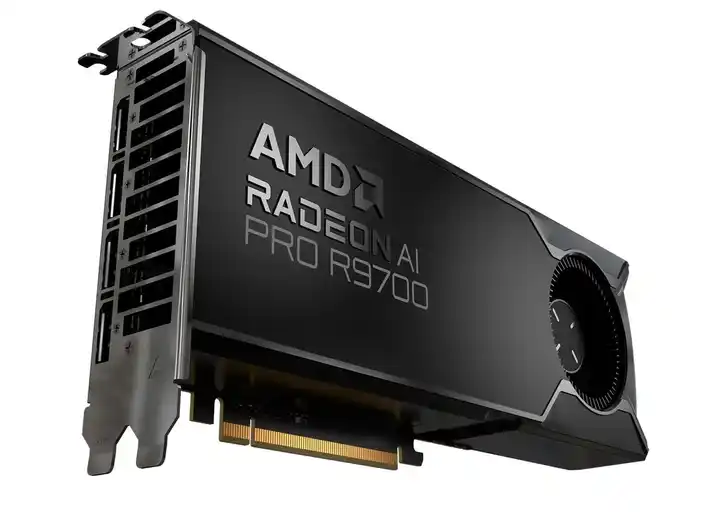AMD Radeon AI PRO R9700

AMD Radeon AI PRO R9700: 32 GB for Local AI and Workstations
Radeon AI PRO R9700 is AMD’s professional graphics card built on the RDNA 4 architecture for local inference and AI model development on workstations. It combines 32 GB of GDDR6, 64 compute units (4096 stream processors), and 128 second-generation AI accelerators, supports FP8/FP16/INT8 precisions, connects via PCIe 5.0 x16, and comes in a dual-slot blower design that’s convenient for dense multi-GPU builds. The ROCm stack and popular frameworks (PyTorch, ONNX Runtime, TensorFlow) are supported.
Key Highlights
-
Architecture: RDNA 4, 64 CUs / 4096 SP, 128 second-gen AI accelerators
-
Memory: 32 GB GDDR6, 256-bit bus — headroom for medium and large models (LLMs, multimodal pipelines, generative graphics)
-
AI Performance: up to ~95.7 TFLOPS FP16 and up to 1531 TOPS INT4 (for AIB variants)
-
Interface & Cooling: PCIe 5.0 x16; blower cooler with front-to-back airflow, dual-slot height for multi-card configurations
-
Software & Ecosystem: ROCm 6.4.x, support for PyTorch/ONNX/TensorFlow; Radeon PRO drivers

What It’s Built For
The R9700 targets local inference of medium-to-large LLMs, fine-tuning, and generative pipelines (text-to-image/video, audio), as well as AI-accelerated workflows in CAD/DCC and scientific computing. Here, ample VRAM, stability under sustained load, and multi-GPU scalability are critical.
Why 32 GB of VRAM Matters
Modern LLMs and diffusion models are memory-hungry. With 32 GB, you can keep an entire model (or a large portion of it) fully resident in VRAM, minimizing spills to system RAM or disk. That reduces latency with long prompts, speeds token decoding, and improves pipeline stability for batch inference.
Hardware Platform & Form Factor
The dual-slot blower shroud exhausts hot air out of the chassis, making it easier to build 2–4 GPU systems. A power envelope around ~300 W fits typical professional cases and PSUs, while predictable front-to-back airflow helps maintain thermals during 24/7 workloads.
Software Environment: ROCm and Frameworks
ROCm support makes the card a fit for standard AI stacks: PyTorch, ONNX Runtime, and TensorFlow. For workstations, PRO drivers focus on stability, certification, and reproducibility, alongside profiling and debugging tools. This lowers migration friction from alternative platforms and speeds up time to production.
Positioning in the Lineup
By die and overall characteristics, the R9700 is close to consumer-class counterparts, but it’s tuned for professional AI workloads: expanded VRAM, pro-grade drivers, and a blower design. In tasks where memory capacity and stability outweigh gaming-style clocks, it delivers predictable results and better resource utilization.
Availability & Pricing
Workstation vendors already offer configurations with the R9700; AIB board versions are available at retail. Actual pricing depends on region, taxes, and cooler design, aligning with the typical class of professional adapters featuring 32 GB of VRAM.
Who Should Consider It
-
AI developers and data scientists building local LLM and multimodal pipelines
-
Studios and integrators needing scalable 2–4 GPU workstation builds
-
CAD/DCC engineers and research teams that rely on PRO drivers and long, stable runs
Specifications (at a Glance)
-
GPU: RDNA 4, 64 CUs / 4096 SP, 128 second-gen AI accelerators
-
Memory: 32 GB GDDR6, 256-bit
-
Interface: PCIe 5.0 x16
-
Cooling: Dual-slot blower (front-to-back)
-
Software: ROCm 6.4.x; PyTorch / ONNX Runtime / TensorFlow
-
Peak Metrics (AIB): ~95.7 TFLOPS FP16; up to 1531 TOPS INT4
-
Typical Power Target: ~300 W (reference/ES)
Conclusion
Radeon AI PRO R9700 fills a crucial niche of local AI without memory compromises: 32 GB of VRAM, pro-grade software, and a form factor suited to multi-GPU arrays. It’s a pragmatic choice for teams that need a quiet, predictable, and scalable workstation for LLMs, generative models, and AI-accelerated media pipelines.
Basic
Memory Specifications
Theoretical Performance
Miscellaneous
Benchmarks
Compared to Other GPU
Share in social media
Or Link To Us
<a href="https://cputronic.com/index.php/gpu/amd-radeon-ai-pro-r9700" target="_blank">AMD Radeon AI PRO R9700</a>